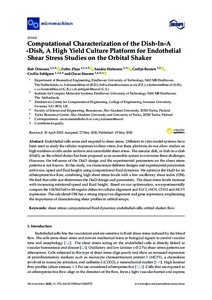Computational Characterization of the Dish-In-A-Dish, A High Yield Culture Platform for Endothelial Shear Stress Studies on the Orbital Shaker
Carlijn Bouten; Sandra Hofmann; Oscar Stassen; Rob Driessen; Feihu Zhao; Cecilia Sahlgren
Computational Characterization of the Dish-In-A-Dish, A High Yield Culture Platform for Endothelial Shear Stress Studies on the Orbital Shaker
Carlijn Bouten
Sandra Hofmann
Oscar Stassen
Rob Driessen
Feihu Zhao
Cecilia Sahlgren
MDPI
Julkaisun pysyvä osoite on:
https://urn.fi/URN:NBN:fi-fe2021042825207
https://urn.fi/URN:NBN:fi-fe2021042825207
Tiivistelmä
Endothelial cells sense and respond to shear stress. Different in vitro model systems have been used to study the cellular responses to shear stress, but these platforms do not allow studies on high numbers of cells under uniform and controllable shear stress. The annular dish, or dish-in-a-dish (DiaD), on the orbital shaker has been proposed as an accessible system to overcome these challenges. However, the influence of the DiaD design and the experimental parameters on the shear stress patterns is not known. In this study, we characterize different designs and experimental parameters (orbit size, speed and fluid height) using computational fluid dynamics. We optimize the DiaD for an atheroprotective flow, combining high shear stress levels with a low oscillatory shear index (OSI). We find that orbit size determines the DiaD design and parameters. The shear stress levels increase with increasing rotational speed and fluid height. Based on our optimization, we experimentally compare the 134/56 DiaD with regular dishes for cellular alignment and KLF2, eNOS, CDH2 and MCP1 expression. The calculated OSI has a strong impact on alignment and gene expression, emphasizing the importance of characterizing shear profiles in orbital setups.
Kokoelmat
- Rinnakkaistallenteet [19204]
